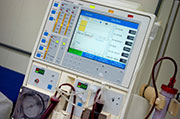- Navigating Your Midlife Crisis: Embracing New Possibilities
- City Raccoons Showing Signs of Domestication
- Mapping the Exposome: Science Broadens Focus to Environmental Disease Triggers
- One Week Less on Social Media Linked to Better Mental Health
- Your Brain Changes in Stages as You Age, Study Finds
- Some Suicide Victims Show No Typical Warning Signs, Study Finds
- ByHeart Formula Faces Lawsuits After Babies Sickened With Botulism
- Switch to Vegan Diet Could Cut Your Greenhouse Gas Emissions in Half
- Regular Bedtime Does Wonders for Blood Pressure
- Dining Alone Could Mean Worse Nutrition for Seniors
Millions of Kidney Failure Patients Die for Lack of Treatment: Study


More than 2 million kidney failure patients worldwide die prematurely every year because they can’t get treatment, a new study finds.
Researchers analyzed data from 123 countries with 93 percent of the world’s population, and found there were between 5 million to almost 10 million kidney failure patients who required either dialysis or a kidney transplant in 2010.
Of the 2.6 million patients who were treated, 78 percent received dialysis. Of those who received treatment, nearly 93 percent lived in high- to high-middle-income nations, the findings showed.
The investigators also calculated that between 2 million and 7 million kidney failure patients who could have been kept alive if they received either dialysis or a kidney transplant died prematurely because they could not get treatment.
Most of the premature deaths occurred in China, India, Indonesia, Pakistan and Nigeria, where less than one-fourth of eligible kidney failure patients receive treatment, according to the study in the March 13 issue of The Lancet.
“The high cost of current dialysis techniques are unaffordable to most people who need it,” study author Vlado Perkovic, a professor at the George Institute for Global Health and the University of Sydney, Australia, said in a journal news release.
“With the number of people receiving dialysis or kidney transplantation set to more than double — to over 5 million by 2030 — there is a dire need for low-cost dialysis techniques, as well as population-wide prevention programs to tackle the key risk factors for end-stage kidney disease, including diabetes, high blood pressure and obesity,” Perkovic added.
The study has prompted three international kidney health groups to launch a worldwide competition to design the first affordable dialysis machine. The prize is $100,000.
“Dialysis machines purify the blood, replacing an essential function of the kidneys. If we can develop an affordable dialysis machine with low operating costs, that runs on solar power and uses local water sources, many more people will have access to the treatment and millions of lives could be saved,” Perkovic said.
Writing in an accompanying commentary, Josef Coresh, from Johns Hopkins University in Baltimore, and Tazeen Jafar, from Duke-NUS Graduate Medical School in Singapore, said, “The time has come to include treatment of kidney failure, and its prevention by detection and management of chronic kidney disease, in the global health agenda.”
More information
The U.S. National Kidney Disease Education Program has more about kidney failure.
Source: HealthDay
Copyright © 2025 HealthDay. All rights reserved.










